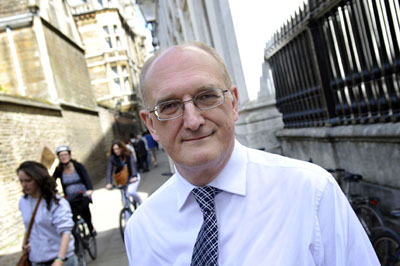Don’t wreck the research pipeline

Where industry representatives always pressure for more appliedscience, Mr. Borysiewicz (currently Vice-Chancellor of theUniversity of Cambridge and previously head of the UK’s MedicalResearch Council) regards the fundamental research done now simplyas the applied research done in the future. Mr. Borysiewicz was thekey note speaker at LERU’s 10th Anniversaryconference:
“Economic growth is the priority of every European government,and it can’t come soon enough. How can universities help?Europe’s research universities are already making a huge economiccontribution: that much is obvious. We educate the futureworkforce, we perform research which governments, business andindustry commission through research contracts, and we makediscoveries and inventions which, formalised in recent years as’technology transfer’, are put directly to work by the privatesector to generate economic return.”
The Cambridge miracle
“An example from my university: in 1960, a pair ofCambridge graduates formed a company called Cambridge Consultants,starting the development of a cluster of high-tech companies aroundthe University. This was later described as ‘the CambridgePhenomenon’: the process by which entrepreneurial scientistscreated companies to take advantage of the proximity to a greatresearch university – and, as the cluster grew, to other companiesdoing similar things. Around the city we now have over 1,400high-tech and bio-tech companies, from tiny recent ‘spin-outs’ fromuniversity laboratories to arms of multinational companies likeMicrosoft. Eleven companies which started in the Cambridgecluster are now valued at over 1 billion euro – including Autonomywhose business software is in use in every industry, and ARM, whosemicrochips are in your mobile phone, your car and your TV.”
“What is less obvious – indeed counter-intuitive – is thatuniversities’ contribution to the economy is so effective preciselybecause it is not our primary objective. Economicproductivity is a by-product of the teaching and research that weperform for other reasons. If it were turned into a primaryobjective – if universities became the Research and Developmentbranch of Big Industry – then our distinctive contribution would belost. The ‘Cambridge Phenomenon’ was unplanned,and in many ways unexpected: it is hard to imagine that it wouldhave been more successful if the University had deliberately setout to create that economic effect. “
New target molecule
“One reason for this is that the discoveries that make thebiggest contribution economically tend to result from blue-skies,fundamental research, not applied, ‘near-market’ research. Ifa pharmaceutical company sets universities the task of improvingthe efficiency of a particular drug, for example, then the resultwill be economically and societally useful, but limited and maybemore effectively done within the company. However, a morefundamental question such as identifying a new target molecule isfar better sited in a large multidisciplinary research intensiveUniversity.”
“In such a circumstance, a university researcher primarily setsout, from curiosity, to discover how a fundamental biologicalprocess works, and the results can be unlimited – andtransformative. This is what Francis Crick and James Watsondid in Cambridge’s Cavendish Laboratories in 1952: their discoveryof the structure of DNA has had an effect on all our lives (and, asan example of economic benefit as a by-product, has generateduncountable billions of euro).”
Not-yet-applied
“The two examples are of course connected: today’spharmaceutical research relies on yesterday’s ‘blue skies’research. Although the pipeline from one to the other is long(studies in some fields have suggested as long as 17 years) it isevident that the pipeline must not be broken – the basic researchwe do now will be applied by our successors in the years tocome. We must not leave the cupboard bare for them. George Porter – a former President of the Royal Society, the UK’sscience academy – went further, insisting that fundamental researchand applied research are at heart the same thing: ‘there aretwo types of research: applied, and not-yet-applied’.”
“Europe is fortunate to have strong, research-intensiveuniversities which can step up to meet these challenges. Manyof them are members of the League of European Research Universities(LERU) which is asking, at its 10th Anniversary Conference thisyear, what the research university of the future will looklike. It is a timely question, since the European Union iscompleting the design of its next research funding framework,Horizon 2020 – a programme that will see more than 80 billion euroover 7 years directed at research and innovation in Europe. These large sums have the ability to shape how Europe’suniversities develop.”
The last institution to integrate knowlegde
“Should our universities focus only on fundamental, blue-skiesresearch, and leave ‘applied’ research and innovation to researchinstitutes, and private-sector R&D labs? The example ofthe Cambridge Phenomenon argues strongly against this: whatthe University of Cambridge can offer to the companies in thecluster is access to an entire spectrum of research fromfundamental to applied, with the support services (technologytransfer offices, science parks and incubators, seed funding) thatgo with it. Separating “applied” from “not-yet-applied” wouldcertainly not be wise, and may not even be possible.”
“It is important, then, that universities are the location forresearch of all kinds – not least because universities are the lastinstitutions able to integrate knowledge from many differentsources and many different disciplines. Universities canidentify interesting developments in unexpected places and combinethem to produce practical solutions to big problems.”
Onerous resposibilities
“We can do this because of our academic breadth, because we areautonomous, and because we give freedom to our individualresearchers to follow promising scents. Although ourphysicists and biotechnologists might invent a new gadget with thepotential for financial profit, our arts and humanities faculties -sociologists, economists, lawyers – can transform that potentialinto sustainable socio-economic benefit. As integrators, wecan match research funding to societal problems.”
“In designing Horizon2020, then, the EU should recognise that itis university research, both applied and “not yet applied”, thatproduces the sustainable, long-term growth that Europe desperatelyneeds. “
“It is worth asking why universities want these onerousresponsibilities. The answer lies in our mission: to servesociety. If ever there was a time when academia was incontrast to the ‘real world’, that time is surely over. Serving society is at the core of what we do. By pursuingresearch in all disciplines and at all points in the spectrum, fromthe most direct form of applied innovation to the most fundamentalinquiry into the way the world works, Europe’s universities holdthe key to growth in our economies – and our societies.”
LERU ahead
The League of European Research Universities (LERU) is anassociation of 21 leading research-intensive universities thatshare the values of high-quality teaching within an environment ofinternationally competitive research. Founded in 2002, LERUadvocates education through an awareness of the frontiers of humanunderstanding; the creation of new knowledge through basicresearch, which is the ultimate source of innovation in society;and the promotion of research across a broad front in partnershipwith industry and society at large.
Meest Gelezen
‘Free riding brengt het hoger onderwijs in de problemen’
Vrouwen houden universiteit draaiende, maar krijgen daarvoor geen waardering
Hbo-docent wil wel rolmodel zijn, maar niet eigen moreel kompas opdringen
‘Sluijsmans et al. slaan de plank volledig mis’
Aangepast wetsvoorstel internationalisering dient vooral samenleving in plaats van student

